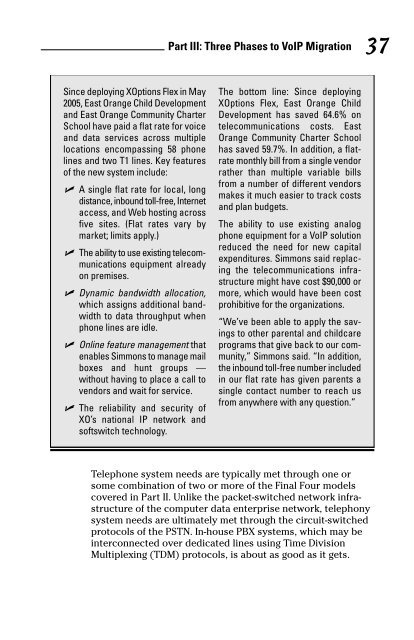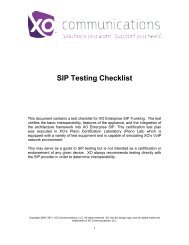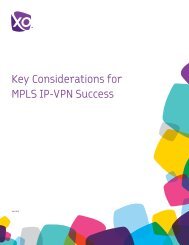VoIP for Dummies Book - XO Communications
VoIP for Dummies Book - XO Communications
VoIP for Dummies Book - XO Communications
You also want an ePaper? Increase the reach of your titles
YUMPU automatically turns print PDFs into web optimized ePapers that Google loves.
Since deploying <strong>XO</strong>ptions Flex in May<br />
2005, East Orange Child Development<br />
and East Orange Community Charter<br />
School have paid a flat rate <strong>for</strong> voice<br />
and data services across multiple<br />
locations encompassing 58 phone<br />
lines and two T1 lines. Key features<br />
of the new system include:<br />
� A single flat rate <strong>for</strong> local, long<br />
distance, inbound toll-free, Internet<br />
access, and Web hosting across<br />
five sites. (Flat rates vary by<br />
market; limits apply.)<br />
� The ability to use existing telecommunications<br />
equipment already<br />
on premises.<br />
� Dynamic bandwidth allocation,<br />
which assigns additional bandwidth<br />
to data throughput when<br />
phone lines are idle.<br />
� Online feature management that<br />
enables Simmons to manage mail<br />
boxes and hunt groups —<br />
without having to place a call to<br />
vendors and wait <strong>for</strong> service.<br />
� The reliability and security of<br />
<strong>XO</strong>’s national IP network and<br />
softswitch technology.<br />
Part III: Three Phases to <strong>VoIP</strong> Migration 37<br />
The bottom line: Since deploying<br />
<strong>XO</strong>ptions Flex, East Orange Child<br />
Development has saved 64.6% on<br />
telecommunications costs. East<br />
Orange Community Charter School<br />
has saved 59.7%. In addition, a flatrate<br />
monthly bill from a single vendor<br />
rather than multiple variable bills<br />
from a number of different vendors<br />
makes it much easier to track costs<br />
and plan budgets.<br />
The ability to use existing analog<br />
phone equipment <strong>for</strong> a <strong>VoIP</strong> solution<br />
reduced the need <strong>for</strong> new capital<br />
expenditures. Simmons said replacing<br />
the telecommunications infrastructure<br />
might have cost $90,000 or<br />
more, which would have been cost<br />
prohibitive <strong>for</strong> the organizations.<br />
“We’ve been able to apply the savings<br />
to other parental and childcare<br />
programs that give back to our community,”<br />
Simmons said. “In addition,<br />
the inbound toll-free number included<br />
in our flat rate has given parents a<br />
single contact number to reach us<br />
from anywhere with any question.”<br />
Telephone system needs are typically met through one or<br />
some combination of two or more of the Final Four models<br />
covered in Part II. Unlike the packet-switched network infrastructure<br />
of the computer data enterprise network, telephony<br />
system needs are ultimately met through the circuit-switched<br />
protocols of the PSTN. In-house PBX systems, which may be<br />
interconnected over dedicated lines using Time Division<br />
Multiplexing (TDM) protocols, is about as good as it gets.






